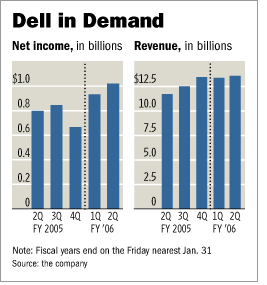Dell's Net Rises on Overseas Strength

Deep Discounts Don't Help In U.S. Market, but Sales To Europe and Asia Pick Up
By GARY MCWILLIAMS Staff Reporter of THE WALL STREET JOURNAL August 12, 2005
Dell Inc. reported fiscal second-quarter profit rose 28% on a tax adjustment and strong sales in Europe and Asia, but deep discounting in personal-computer prices failed to ignite U.S. sales.
The world's largest PC maker said price cuts didn't lift sales enough to offset the impact of the discounts on profit. It offered a tepid outlook for the current quarter's sales, on the heels of Cisco Systems Inc.'s warning earlier this week.
Dell fell $3.03, or 7.7%, to 36.55 in after-hours trading on top of losing 15 cents, to $39.58, in 4 p.m. trading on the Nasdaq Stock Market. The stock is off 6.1% this year after ending 2004 at $42.14.
The Dell price-cutting benefited consumers, who gobbled up cheap PCs. Spurred by declining prices overseas and rising demand, world-wide PC shipments in the calendar second-quarter jumped 18.1%, the highest rate of increase for the period in the last five years, market-watcher International Data Corp. estimated.
Dell's results also highlighted the growing role of sales in Asia and Europe, regions that historically lagged U.S. growth and have thinner profits. Dell said its unit sales in Europe climbed 35% and jumped 45% in China. Industry shipments were nearly six percentage points above IDC's initial world-wide growth estimate, said Loren Loverde, an IDC analyst.
The Round Rock, Texas, computer-maker reported net of $1.02 billion, or 41 cents a share, for the fiscal quarter ended July 29. Excluding a three-cents-a-share reversal of a tax payment, profit was at the midpoint of its May earnings forecast. In the year-ago quarter, it earned $799 million, or 31 cents a share.
Revenue was up 15% to $13.43 billion from $11.71 billion.
Kevin B. Rollins, Dell's chief executive, said the company miscalculated the effects of its price cutting and failed throttle back when sales didn't rise as fast as expected. He also said sales to U.S. government agencies, which have been weak for a year, fell even further.
"We got a bit more aggressive than we needed to, and the elasticity wasn't there," he said. "Frankly, we executed poorly on managing overall selling prices, particularly in consumer [PCs], but across the board."
Prices for key parts such as memory chips and liquid-crystal displays didn't fall as sharply as in prior quarters, Dell said. The company uses lower component costs to lower prices and lift profit.
It sold a desktop PC for $299 last quarter that was nearly identical to a PC that cost $499 a year earlier. The price drops have helped Dell lift its share in emerging markets such as Asia, but they also cut average selling prices by 8.1% from last year, the company said.
Lower selling prices reduced gross margin, or profit after manufacturing cost, from recent highs. Dell reported gross margin of 18.6%, up from a year ago, but down compared with the first quarter's 18.8%. The unit sales pushed the company's second-calendar-quarter share of shipments to new peaks of 19% world-wide and 34.4% in the U.S., estimated IDC.
Dell forecast third-quarter profit of between 39 cents and 41 cents a share on revenue of between $14.1 billion and $14.7 billion. At the midpoints of the profit and revenue estimates, Dell's forecasts are below Wall Street's current estimate of profit of 41 cents a share on sales of $14.63 billion.
The below-par sales growth also undercut what had been fast gains in cash flow in recent quarters. Dell said it generated $900 million in cash, up from $700 million a year ago but well below the $1.2 billion pace of the last quarter.

0 Comments:
Post a Comment
<< Home